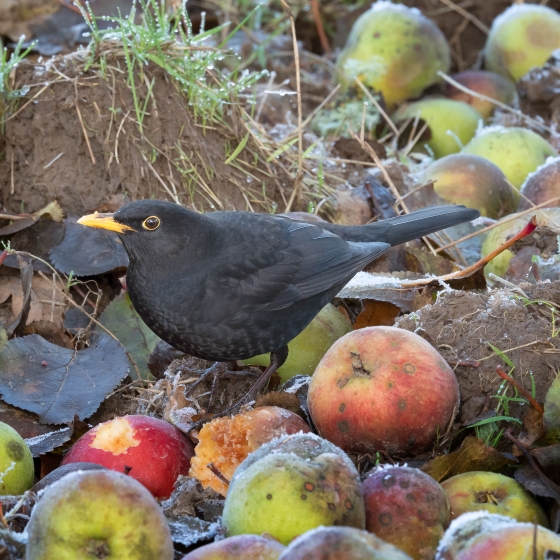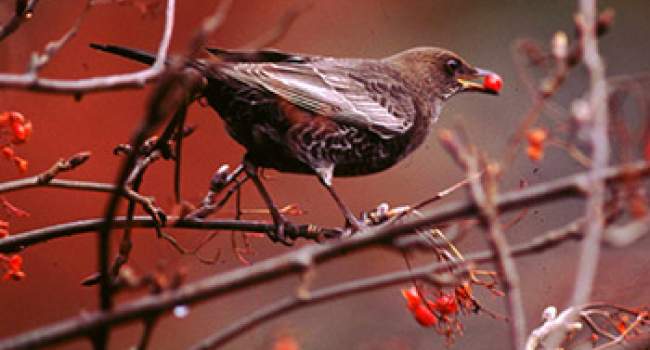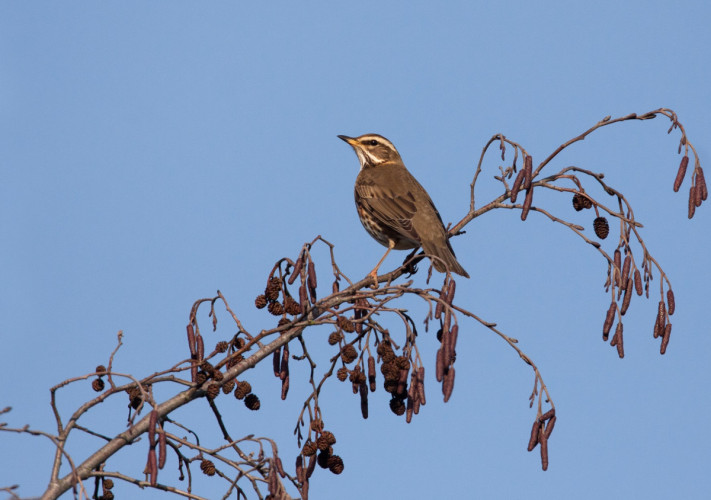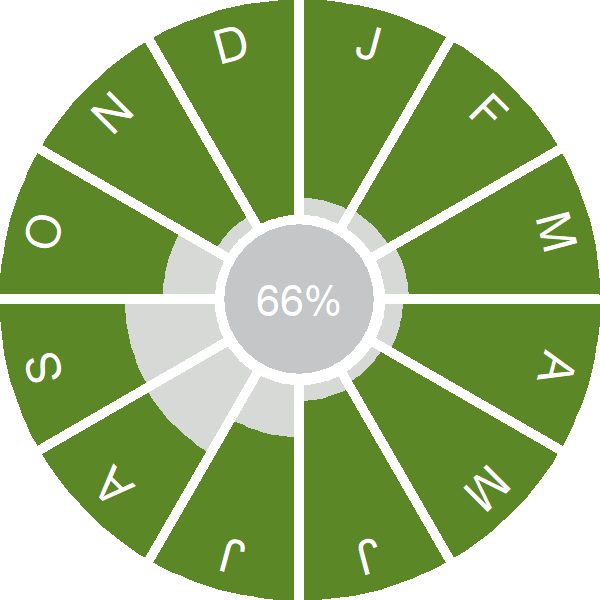Blackbird
Turdus merula (Linnaeus, 1758)
B.
 BLABI
BLABI  11870
11870

Family: Passeriformes > Turdidae

The Blackbird is one of our most common and familiar birds. It is particularly numerous in gardens, but can be found almost everywhere in Britain & Ireland, apart from the highest ground.
This species forages on the ground, and is most often seen turning over leaf litter, probing the soil for food, or visiting flat feeders like bird tables. Adult male birds are black with a contrasting yellow bill and eyering, whilst females are browner and streakier. The Blackbird's fluting, melodic song, often performed from a high perch, is a particular feature of summer evenings.
Breeding numbers have increased in the UK since the mid-1990s, following a decline during the 1970s and 1980s. The UK also hosts many additional birds from northern Europe in the winter.
Exploring the trends for Blackbird
Our Trends Explorer will also give you the latest insight into how the UK's Blackbird population is changing.
trends explorerIdentification
Identifying Ring Ouzel and Blackbird

With Ring Ouzel migration about to reach its peak this wonderful thrush can turn up almost anywhere. Check out the latest identification video to help separate this species from Blackbird, both on the ground, in flight and by song.
- ‹ previous
- 2 of 2
SONGS AND CALLS
Listen to example recordings of the main vocalisations of Blackbird, provided by xeno-canto contributors.
Flight call
Alarm call
Call
Song
Develop your bird ID skills with our training courses
Our interactive online courses are a great way to develop your bird identification skills, whether you're new to the hobby or a competent birder looking to hone your abilities.
Browse training coursesStatus and Trends
Population size and trends and patterns of distribution based on BTO surveys and atlases with data collected by BTO volunteers.
CONSERVATION STATUS
This species can be found on the following statutory and conservation listings and schedules.
POPULATION CHANGE
Both CBC/BBS and CES data show long-term declines in Blackbird abundance up to about the mid 1990s followed by a strong but partial recovery, which currently has stalled. The BBS map of change in relative density between 1994-96 and 2007-09 indicates that increase over that period occurred mainly in high-rainfall parts of the country, particularly Wales, northwestern England and southern Scotland. More recent BBS data suggest that this remains the case: they show a significant decline in London since 1995, stability in the South-east, East and North-east English regions, but increasing populations in the other five English governmental regions and in Northern Ireland, Scotland and Wales (Harris et al. 2020). The moderate-decline criterion for amber listing is no longer met, and the species has been listed in the green category since 2002.
There has been an increase across Europe since 1980 (PECBMS: PECBMS 2020a>).
| UK breeding population |
-19% decrease (1967–2022) 
|
Exploring the trends for Blackbird
Our Trends Explorer will also give you the latest insight into how the UK's Blackbird population is changing.
trends explorerDISTRIBUTION
Blackbirds are among the commonest birds in Britain & Ireland, with records from 96% of 10-km squares in both the winter and the breeding season; it is absent only from a few upland and remote island 10-km squares. High densities in the east and midlands of Ireland and the lowlands of England and Wales contrast with low densities in the uplands of northern England, Scotland, Wales and western Ireland.
Occupied 10-km squares in UK
| No. occupied in breeding season | 2881 |
| % occupied in breeding season | 95 |
| No. occupied in winter | 2903 |
| % occupied in winter | 96 |
European Distribution Map
European Breeding Bird Atlas 2
Breeding Season Habitats
| Most frequent in |
Villages, Towns 
|
| Also common in | Scrub, Arable Farmland, Pasture Farmland, Deciduous Wood |
Relative frequency by habitat
Relative occurrence in different habitat types during the breeding season.

DISTRIBUTION CHANGE
Although there has been little overall change in range size, abundance within the range has increased, particularly in square in parts of Wales and Scotland.
Change in occupied 10-km squares in the UK
| % change in range in breeding season (1968–72 to 2008–11) | -0.6% |
| % change in range in winter (1981–84 to 2007–11) | +2.2% |
SEASONALITY
Blackbird is a common and widely recorded species, encountered on over 60% of complete lists in most months.

Movement
Information about movement and migration based on online bird portals (e.g. BirdTrack), Ringing schemes and tracking studies.
RINGING RECOVERIES
View a summary of recoveries in the Online Ringing Report.
Foreign locations of birds ringed or recovered in Britain & Ireland

Biology
Lifecycle and body size information about Blackbird, including statistics on nesting, eggs and lifespan based on BTO ringing and nest recording data.
PRODUCTIVITY & NESTING
Exploring the trends for Blackbird
Our Trends Explorer will also give you the latest insight into how the UK's Blackbird population is changing.
trends explorerSURVIVAL & LONGEVITY
View number ringed each year in the Online Ringing Report
Exploring the trends for Blackbird
Our Trends Explorer will also give you the latest insight into how the UK's Blackbird population is changing.
trends explorerBIOMETRICS
Wing Length 
|
Adults | 130.8±4.4 | Range 124–138mm, N=81803 |
| Juveniles | 129.8±3.9 | Range 124-136mm, N=53822 | |
| Males | 132.9±3.9 | Range 126–139mm, N=42493 | |
| Females | 128.6±3.8 | Range 123–134mm, N=39130 |
Body Weight 
|
Adults | 102±12.1 | Range 87.0–122g, N=65475 |
| Juveniles | 100±9.3 | Range 86.0–116g, N=42885 | |
| Males | 103±12.6 | Range 87.0–124g, N=33791 | |
| Females | 101±11.5 | Range 86.0–120g, N=31528 |
Feather measurements and photos on featherbase 
CODES & CLASSIFICATION
Ring size 
|
C |
Field Codes 
|
2-letter: B. | 5-letter code: BLABI | Euring: 11870 |
For information in another language (where available) click on a linked name
Research
Interpretation and scientific publications about Blackbird from BTO scientists.
CAUSES AND SOLUTIONS
Causes of change
The causes of change are uncertain although it is likely that reduced survival drove the initial declines. Agricultural intensification may have contributed to the decline in farmland, but other factors probably operated in woodland and urban habitats.
Further information on causes of change
CBC results show that the decline began in the mid 1970s. It is likely that reduced survival drove the decline (Siriwardena et al. 1998a), although there has been little overall change in survival as recorded by CES since 1983. Adult survival in an intensive colour-ringing study was lowest in the spring during the early breeding season and highest during the autumn (Robinson et al. 2010a); the survival rates found by this study were similar to those found by an earlier study in the 1970s (Batten 1978). However, the 2010 study covered a small geographical area and the survival rates from this area may not be representative of the whole of the UK. Subsequent demographic analysis of national data indicates that annual population changes actually correlate best with adult survival, although population processes appear to differ between eastern and western Britain (Robinson et al. 2012). Fledgling numbers per breeding attempt increased during the population decline and are now decreasing again, suggesting that productivity is density-dependent. Agricultural intensification is likely to have contributed to the population decline (Fuller et al. 1995) but, since numbers fell in woodland as well as farmland, additional factors probably operated. Analysis of nest record data suggests that different factors may affect nest survival in urban and countryside habitats, and that nest productivity is higher in intermediate (urban rural) habitats (Miller et al. 2017).
Information about conservation actions
The causes of the decline from the 1970s to the mid-1990s are uncertain and hence it is also unclear which conservation actions will be most likely to help reverse the declines. Blackbird numbers did increase from the late 1990s until around 2010, suggesting that the earlier issues may no longer be occurring, but these increases have stalled and numbers remain substantially lower than in the late 1960s.
Decreases in farmland may relate to agricultural intensification, where conservation actions to support other species may also benefit Blackbird, particularly those that could aid survival as this is suspected to be the main cause of the decline. These could include providing supplementary food over winter, managing hedgerows or woodland habitat for wildlife, and providing additional habitat, e.g. wild bird seed or cover mixtures, set-aside or grass buffer strips/margins. As Blackbird is a partial migrant, local conservation actions to support birds in winter will not necessarily benefit local populations, and changes over a large scale may hence be required in order for conservation actions to have a significant effect on British (and European) populations. During the breeding season, soil moisture can affect breeding success (Miller et al. 2017), and therefore policies that encourage damper soil may benefit Blackbirds, e.g. reduced drainage.
Much of the population of this species lives in woodland and urban areas, where declines have also occurred. Similar conservation actions to try to improve habitats in these areas would be prudent, but further research is needed before specific targeted actions for Blackbird can be proposed.
PUBLICATIONS (2)

Combining host and vector data informs emergence and potential impact of an Usutu virus outbreak in UK wild birds
Charting the impact of a Usutu virus outbreak in UK Blackbirds
The identification of the Usutu virus in Greater London in the summer of 2020 raises questions about the extent of the incursion and its impacts on wild bird populations.

Nocturnal flight calling behaviour of thrushes in relation to artificial light at night
Nocturnal thrushes affected by artificial light
New research from BTO has investigated the effect of artificial light at night on birds, indicating that nocturnal migrants are attracted to more brightly lit areas.
Links to more studies from ConservationEvidence.com
- Avian responses to late-season grazing in a shrub-willow floodplain
- Breeding biology and success of a reintroduced population of the critically endangered puaiohi (Myadestes palmeri)
- Response of bird communities to silvicultural thinning of Mediterranean maquis
Read more studies about Blackbird on Conservation Evidence >
Would you like to search for another species?













Share this page